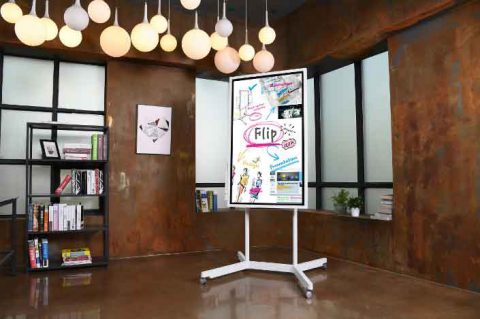Financial Mail Office
5 Huddle Room Essentials
Modern office design favours large open workspaces, with plenty of tiny, private “huddle rooms” for impromptu meetings and videoconferencing sessions. To get the most out of these spaces, they need to be properly equipped, straightforward to set up and capture all the important details of what’s been said and done.
Here’s the five essential technologies that they shouldn’t be without.
Smart flipboards
Smart flipboards are a relatively recent innovation, that combines the digital capture of an interactive screen with the portability and orientation of a flipchart.
 Where earlier attempts at interactive displays could come across as a bit gimmicky or slow, faster processors and better touchscreen response times make them feel more natural.
Where earlier attempts at interactive displays could come across as a bit gimmicky or slow, faster processors and better touchscreen response times make them feel more natural.
“People prefer analogue collaboration tools. They want simple, familiar tools,” says Cambridge Mokanyane, Chief Marketing Officer at Samsung South Africa, when asked about research in to new product lines.
“They wanted the ideas, conclusions and plans that came out of meetings captured, archived and easily shareable.”
Videoconferencing hubs
Not so long ago, video hubs used to involve large, server-type boxes underneath TVs at one end of the room, and an IT technician to set them up. Today’s hubs sit in the middle of the table and work in the same way as desktop or mobile applications that we’re used to.
Analysts at Global Market Insights reckon that videoconferencing will be a $20-billion global market by 2024, thanks to falling prices for equipment and the fact that as teams become more distributed, remote workers need to dial in to take part in regular discussions.
Better wifi
Poor WiFi connectivity is still the bane of many an otherwise productive meeting, and the good news is that there’s a significant upgrade to current technology which should be available by the end of the year.
Devices and routers supporting WiFi 6 should be available later this year, and capable of supporting network speeds of 9.6Gbps, or almost three times faster than WiFi 5.
Room scheduling panels
Many large corporates in South Africa have already adopted the room scheduling panel. This technology is a display that runs software that allows employees to view and make bookings for meetings.
These panels are mounted outside the entrance to meeting rooms, preventing interruptions from people who want to check when a meeting ends, and sync with common calendaring software to allow employees to reserve a space from any device they use — an essential for when the huddle space is in high demand.
All-in-one smart displays
Large screens are the mainstay of any board or meeting room, and as they get smarter they’re becoming more likely to be the only thing you’ll need.
“The essential technological solutions for the modern boardroom combine the advantages of smart hardware (such as smart boards) with intelligent productivity and collaboration platforms,” says Colin Baumgart, Director of Consumer and Device Sales at Microsoft South Africa.
The boardroom of the future
As companies become savvier about the benefits of technology in the boardroom, you can expect even more integration of powerful and interesting innovations. Samsung’s Cambridge Mokanyane, says that research is constantly being undertaken to improve workplace efficiency with technological solutions.
“However, while technological discoveries are important, what matters most is the ‘human dimension’ of innovation” he says.
Mokanyane says that future technologies will continue to focus on productivity and interaction based on customer preferences.
Artificial intelligence
Meanwhile, artificial intelligence is also expected to play an increasing role, according to Microsoft’s Colin Baumgart. This includes AI software that can help with language translation between employees from different countries, increase efficiency with the help of virtual assistants that respond to voice, and enhance software with machine learning.
“When it comes to AI, the possibilities are boundless,” Baumgart says. Another trend that’s emerging is the use of mixed reality and augmented reality devices in training and the development of product ideas. “Mixed reality experiences will help businesses and their employees complete crucial tasks faster, safer, more efficiently, and create new ways to connect to customers and partners,” Baumgart notes.






 Sign-up and receive the Business Media MAGS newsletter OR SA Mining newsletter straight to your inbox.
Sign-up and receive the Business Media MAGS newsletter OR SA Mining newsletter straight to your inbox.